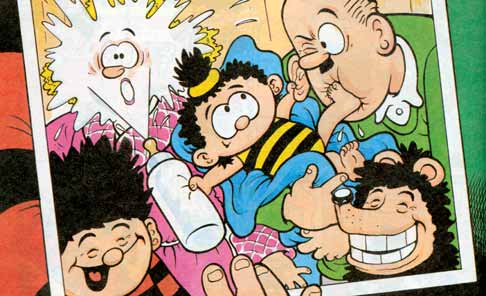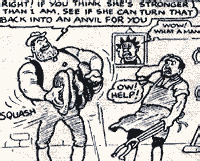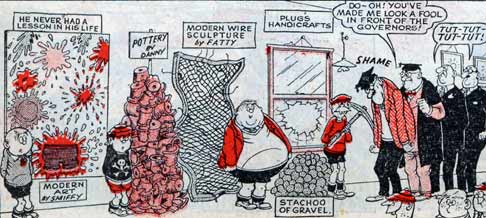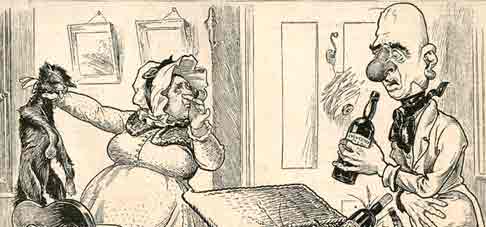
Custard pies in the face, schoolboy pranks, jokes about bottoms and bullies getting their just rewards: all the ingredients of the traditional British humour comic! Where did it all start? Read on...
The origins of the British comedy strip date back to the 19th Century, with weekly black and white tabloid publications such as Funny Folks (1874) and Ally Sloper's Half Holiday (1884, final picture). Being a mixture of social comment and cartoons, these publications were not strictly "comics". However, the irreverent personality of Ally Sloper, the gin-drinking hard-luck hero served as a template for things to come.
Similar "comic papers" followed, shifting their direction towards a younger readership with Comic Cuts and Illustrated Chips (both launched in 1890) and The Funny Wonder (1892).
Inspired by silent cinema, physical slapstick began to dominate the strips. In 1915 The Funny Wonder began featuring a Charlie Chaplin strip on its covers, and more movie stars packed the pages of Film Fun in 1920. Original characters flourished too. "Weary Willie and Tired Tim" (two cheery tramps on the road), "Pitch and Toss" (the comical sailors), and "Homeless Hector" (a stray dog) were typical of the time, but big changes were on the horizon.
 In 1937, The Dandy was launched, and its companion comic The Beano followed a year later. Both were destined to shake up the industry. No tramps or ageing film stars for The Dandy�s cover, but instead, the fish-stealing, mouse-chasing Korky the Cat. On page two was the bristle-chinned no-nonsense hard nut Desperate Dan (left). Both characters are still around today, but The Beano�s biggest stars were yet to come.
In 1937, The Dandy was launched, and its companion comic The Beano followed a year later. Both were destined to shake up the industry. No tramps or ageing film stars for The Dandy�s cover, but instead, the fish-stealing, mouse-chasing Korky the Cat. On page two was the bristle-chinned no-nonsense hard nut Desperate Dan (left). Both characters are still around today, but The Beano�s biggest stars were yet to come.
In 1951, Dennis the Menace, "The World's Wildest Boy", energetically drawn by Davy Law, exploded from the pages of The Beano, starting a chain reaction that would change the face of comics forever. Realising that the "naughty kid-strip" was the stuff of the future, cartoonist Leo Baxendale designed The Bash Street Kids (below) and Minnie the Minx, also for The Beano. Within a few years, comic strips featuring cheeky school kids had supplanted cheery tramps. Youth culture had seized comicland even before the real world knew about it.

Baxendale's modern hectic art style influenced almost every humour comic from that period onward. Another artist of note was Ken Reid, drawing Frankie Stein (The Friendly Monster) for Wham! and later, taking over The Nervs, blue-collar microbes working in the factory-condition innards of obese kid Fatty, (below) for Smash!

Kids loved such comedy-horror, but management were less keen, replacing the anarchic comics on the schedule with more genteel weeklies such as Whizzer and Chips in 1969. Frankie Stein returned in the pages of Shiver & Shake (1973) but his storylines were less macabre, although superby illustrated by Robert Nixon.
Whizzer and Chips had been a big winner, but its formula mix of happy-but-harmless fun was milked dry with Cor!!, Jackpot, Whoopee!, Wow!, and others too numerous to mention. Parodying the entire genre came the foul-mouthed but funny Viz, launched in 1979 by two brothers, Chris and Simon Donald. Its outrageous characters such as Johnny Fartpants (below) and Sid the Sexist ensured Viz a sales peak at over a million copies an issue.

Others jumped on the Viz bandwagon with titles such as Zit, Spit, Poot, Smut, and Brain Damage, imitating Viz's crudeness but not its ability to nail social comment. However, comics were appealing to adults again, as they had a century before.
Realising that kid�s comics needed to reflect changing tastes, IPC launched Oink! in 1986. Sometimes unfairly referred to as a "junior Viz", Oink! had its own identity as a cheekier, ruder comic than other children�s comics, with characters like Burp, the Smelly Alien and Pete and His Pimple (a kid with a giant zit on his nose). Kids loved it, but parents hated it. Ahead of its time, Oink merged into the more traditional Buster comic after just two years.
The establishment balked at Oink's rudeness two decades ago, but now fart gags and zit jokes are commonplace even in the perennial Beano, where Dennis the Menace's new baby sister, Bea (top picture), keeps softies at bay with her smelly nappies. Most of the old comics are gone now, but strips are still to be found in children's magazines such as Toxic - where in the best traditions of British humour, slapstick and light hearted vulgarity still rule!

Image credits: Desperate Dan, from The Dandy (1946), The Bash Street Kids, from The Beano (1960), Bea, from The Beano (1998), all © DC Thomson Ltd. The Nervs, drawn by Ken Reid, from Smash! (1969) © IPC Media. Johnny Fartpants from Viz © Fulchester Industries/Dennis Publishing Ltd.
|
Trivia
The name of the Victorian character Ally Sloper was inspired by the practice of people who sloped (sneaked) into the back alley behind their houses to avoid paying the rent collector!
In the early issues of his comic, Buster was sub-titled "The Son of Andy Capp" - even though the famous Daily Mirror character was never seen in the strip.
The Dandy holds the record for being the world's longest running comic. It's been published every week since 1937, except during World War 2 when paper shortages forced it to come out every two weeks.
Dennis the Menace is also the name of an American newspaper cartoon. By incredible coincidence, both versions first appeared in the same week in 1951!
Grimly Feendish, the creepy crook from the pages of Smash! comic was the subject of a song of the same name by The Damned in 1985.
A copy of The Beano issue 1, from 1938, sold for a record price of �12,100 in a postal auction in March 2004. It�s original price was 2d (in pre-decimal currency). That's less than one pence!
A "life size" statue of Desperate Dan proudly stands in the High Street of Dundee; home town of The Dandy!
At the height of its popularity in the late 1980's, Viz was selling a million copies an issue. Even more impressive, back in the 1950's The Beano sold two million copies a week!
Some people thought TV would kill off comic reading, but comics adapted to suit, from TV Comic in 1951 to today�s The Simpsons monthly, proving that if you can�t beat 'em, put their characters in your comic.
For many years, British comics featured a balanced mixture of humour and adventure strips. Things began to change in the early 1970's when new titles such as Cor!! and Scorcher segregated the genres into seperate comics.
The free gift in Film Fun No.1 (1920) was "A plate of Fatty Arbuckle". Relax; Fatty Arbuckle was a silent movie star of the day, and a "plate" was a photograph!
|


